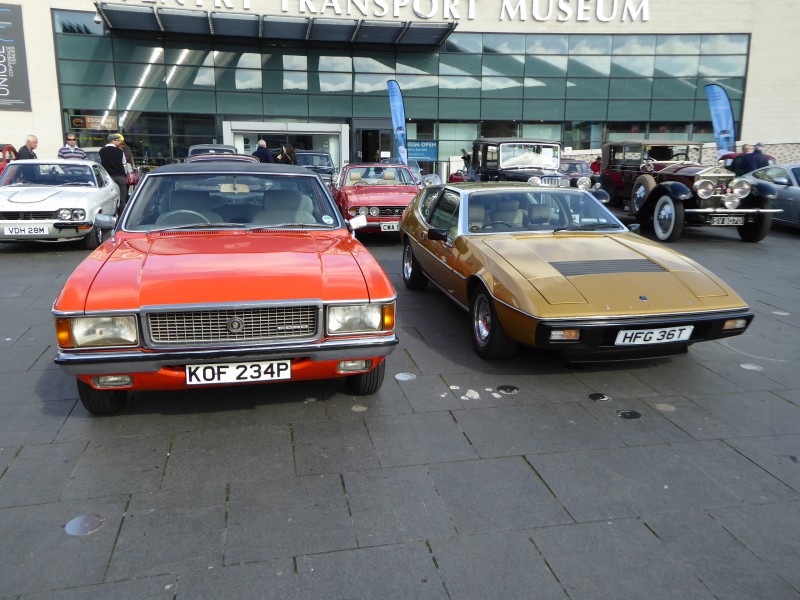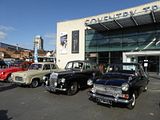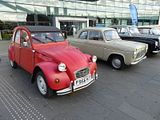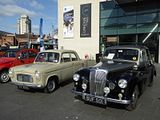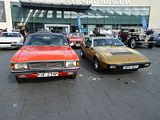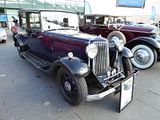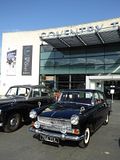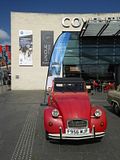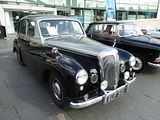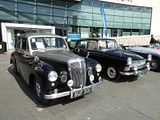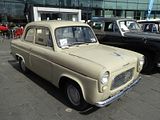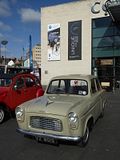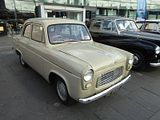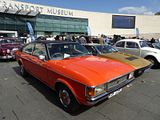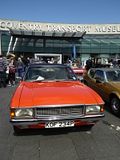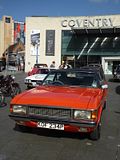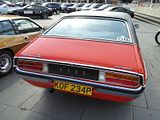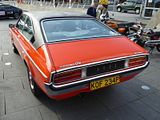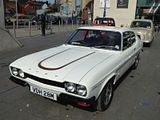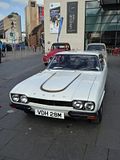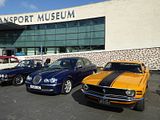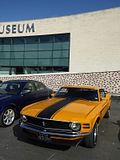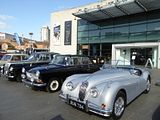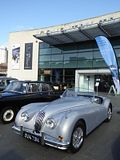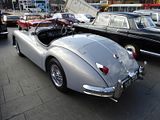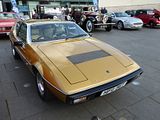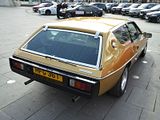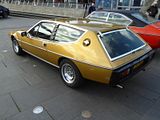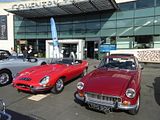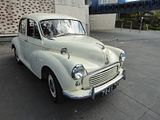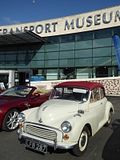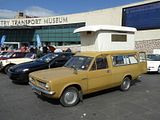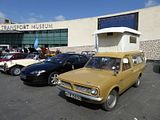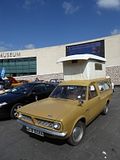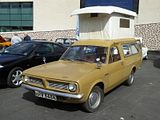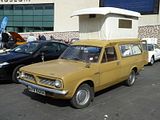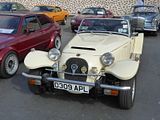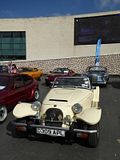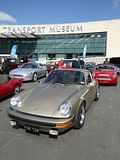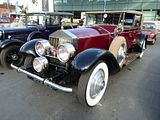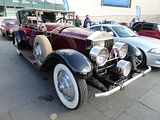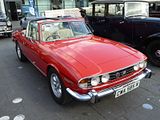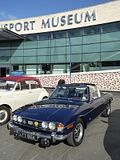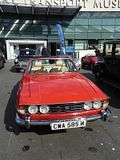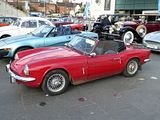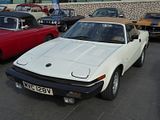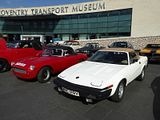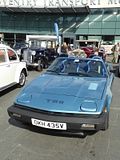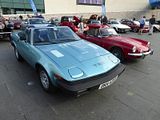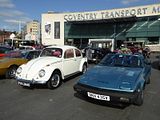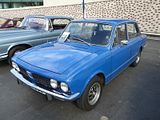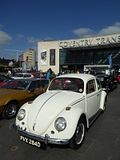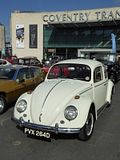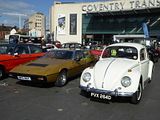It would not surprise me if, before long, someone writes a history of the automotive Breakfast Club. Or they may choose to call it the history of “Cars and Coffee”, as it would seem that the very first of this popular format of event may well be the now extinct one that used to take place in Irvine, California. Whilst it may take some detective work to figure out where the events started, and how they mushroomed in popularity (thank the world of Social Media for that!), there can be no doubting the fact that in the past few years, early weekend morning gatherings of cars and enthusiasts have become extremely popular. In the past few years, I’ve been not just to the one which popularised the genre in the UK, at Goodwood, but at least 6 other venues, and these constitute a mere fraction of the similar events that are held regularly around the UK, and elsewhere. If you go to the same event more than a few times, you will spot there are plenty of display cars that you have seen before, so one advantage of casting your attendance net a little wider, is that you will inevitably find some different cars. That was part of the thinking behind my decision to try out the Coventry Transport Museum Breakfast Club, subject of this report. These meetings were only started in 2014, but would appear to have proved an instant hit, not least because their location, in the centre of Coventry and right in front of the Transport Museum, is perfect:: a large open space which can accommodate a three figure total of cars, on private land, so no worries from traffic wardens, and a Museum on site with a Cafe (for the Coffee bit) and an automotive attraction indoors. Unlike most of the other similar events, Coventry Museum hold theirs on a Saturday, so with another event taking place the following day at nearby Gaydon (a separate report for which will follow), I decided to investigate. The website indicated that to display your car, you need to pre-book, and by the time I decided to attend, the event website declared that they had reached a capacity of bookings. Accordingly, I parked in the Pay and Display round the back of the museum and wandered around to see what was on site. Even by 9am, there were plenty of cars on show and some more arrived during the morning. Here they are:
ARMSTRONG SIDDELEY
Since the event was taking place in Coventry, it seems appropriate to start with a marque which very firmly belongs in the city, Armstrong Siddeley. Car production ceased in 1960, so many will not have heard of this marque, I fear, but those who do know something of the company will recall a series of post war models named after British fighter planes, and a series of distinguished pre-war cars which appealed to the very upper middle class buyer who wanted something special but could not quite stretch to a Bentley or a Rolls Royce. Like many companies, the early years were marked by merger and acquisition. The story starts with Siddeley Autocars, of Coventry, founded by John Davenport Siddeley in 1902. Its products were heavily based on Peugeots, using many of their parts but fitted with English-built bodies. This company merged with Wolseley in 1905 and made stately Wolseley-Siddeley motorcars. They were used by Queen Alexandra and the Duke of York later King George V. In 1909 J. D. Siddeley resigned from Wolseley and took over the Deasy Motor Company, and the company became known as Siddeley-Deasy. In 1912, the cars used the slogan “As silent as the Sphinx” and started to sport a Sphinx as a bonnet ornament, a symbol that became synonymous with descendent companies. During the Second World War the company produced trucks, ambulances, and staff cars. In 1915 airframes and aero-engines started to be produced as well. In April 1919 Siddeley-Deasy was bought out by Armstrong Whitworth Development Company of Newcastle upon Tyne and in May 1919 became Armstrong Siddeley Motors Ltd, a subsidiary with J. D. Siddeley as managing director. In 1927, Armstrong Whitworth merged its heavy engineering interests with Vickers to form Vickers-Armstrongs. At this point, J. D. Siddeley bought Armstrong Siddeley and Armstrong Whitworth Aircraft into his control. In 1928, Armstrong Siddeley Holdings bought Avro from Crossley Motors. Also that year Siddeley partnered with Walter Gordon Wilson, inventor of the pre-selector gearbox, to create Improved Gears Ltd, which later became Self-Changing Gears – the gearbox that should be credited with enabling the marketing tagline “Cars for the daughters of gentlemen”. Armstrong Siddeley manufactured luxury cars, aircraft engines, and later, aircraft. In 1935, J. D. Siddeley’s interests were purchased for £2 million by Tommy Sopwith owner of Hawker Aircraft to form – along with the Gloster Aircraft Company and Air Training Services – Hawker Siddeley, a famous name in British aircraft production. Armstrong Whitworth Aircraft became a subsidiary of Hawker. The aviation pioneer Thomas Octave Murdoch Sopwith – Tommy, later Sir Thomas, Sopwith – became chairman of Armstrong Siddeley Motors, a Hawker Siddeley subsidiary. Armstrong Siddeley was merged with the aircraft engine business of Bristol Aeroplane Company (Bristol Aero Engines) to form Bristol Siddeley as part of an ongoing rationalisation under government influence of the British aircraft and aircraft engine manufacturers. Armstrong Siddeley produced their last cars in 1960. Bristol Siddeley and Rolls-Royce merged in 1966, the latter subsuming the former which remained for a while as an aircraft engine division within Rolls-Royce. In June 1972, Rolls-Royce (1972) Ltd sold all the stock of spares plus all patents, specifications, drawings, catalogues and the name of Armstrong Siddeley Motors Ltd to the Armstrong Siddeley Owners Club Ltd. This meant that “Armstrong Siddeley” and “A-S Sphinx Logo” are trademarks and copyright of the Armstrong Siddeley Owners Club Ltd. The “Siddeley” name survived a while longer in aviation; in Hawker Siddeley Aviation and Hawker Siddeley Dynamics before they joined with others to become British Aerospace (BAe) which with further mergers is now BAE Systems. The first car produced from the 1919 union was a fairly massive machine, a 5-litre 30 hp.A smaller 18 hp appeared in 1922 and a 2-litre 14 hp was introduced in 1923. 1928 saw the company’s first 15 hp six; 1929 saw the introduction of a 12 hp vehicle. This was a pioneering year for the marque, during which it first offered the Wilson preselector gearbox as an optional extra; it became standard issue on all cars from 1933. In 1930 the company marketed four models, of 12, 15, 20, and 30 hp, the last costing £1450. The company’s rather staid image was endorsed during the 1930s by the introduction of a range of six-cylinder cars with ohv engines, though a four-cylinder 12 hp was kept in production until 1936. In 1933, the 5-litre six-cylinder Siddeley Special was announced, featuring a Hiduminium aluminium alloy engine; this model cost £950. Car production continued at a reduced rate throughout 1940, and a few were assembled in 1941. The week that World War II ended in Europe, Armstrong Siddeley introduced its first post-war models; these were the Lancaster four-door saloon and the Hurricane drophead coupe. The names of these models echoed the names of aircraft produced by the Hawker Siddeley Group (the name adopted by the company in 1935) during the war. These cars all used a 2-litre six-cylinder engines, increased to 2.3-litre engines in 1949. From 1953 the company produced the Sapphire, with a 3.4-litre six-cylinder engine. In 1956, the model range was expanded with the addition of the 234 (a 2.3-litre four-cylinder) and the 236 (with the older 2.3-litre six-cylinder engine). The Sapphire 346 sported a bonnet mascot in the shape of a Sphinx with namesake Armstrong Siddeley Sapphire jet engines attached. The 234 and 236 Sapphires might have looked to some of marque’s loyal customers like a radical departure from the traditional Armstrong Siddeley appearance. However, in truth, they were simply too conservative in a period of rapidly developing automotive design. If the “baby Sapphire” brought about the beginning of the end for Armstrong Siddeley, it was because Jaguar had launched the unitary-construction 2.4 saloon in 1955, which was quicker, significantly cheaper, and much better-looking than the lumpy and frumpy 234/236 design. The last model produced by Armstrong Siddeley was 1958’s Star Sapphire, with a 4-litre engine, and automatic transmission. The Armstrong Siddeley was a casualty of the 1960 merger with Bristol; the last car left the Coventry factory in 1960. The car seen here dates from 1935 and is a “Long” 20. The 20 was produced in two versions, “short” and “long” , denoting the wheelbase of the cars. Produced between 1926 and 1936, the 20s featured a 2876cc 20HP 6 cylinder engine. 8847 examples were built though few survive. This 1935 car is an example of the “New” 20hp cars which were built between 1931 and 1936, which featured either long or short wheelbases and with various body styles from sporty open tourers to large grand limousines. The bodies were manufactured both by the factory or by several specialist coach builders. The engine was a 6 cylinder overhead valve of 3150cc. and all cars had the Wilson pre-select gearbox. Some 2650 of these later cars were produced and it is thought that about 90 have survived although many are not now roadworthy. This splendid example was first sold by the Armstrong Siddeley Bond Street showrooms in 1935 to a Mrs Threlfall from Bristol who sold it in 1937 to Dr D. Bedford of Kegworth who kept it chauffeur driven for 32 years until his death when it passed to his chauffeur whose family kept it for a further 30 years! A full restoration was commenced in the late ’90s including a bare metal respray and a complete engine rebuild. The car was purchased in 2010 by the current owner showing a genuine 62,132 miles and since then the car has travelled a further 9,000 miles attending events and shows across the country. It is a most imposing motorcar.
AUSTIN
In complete contrast is this A55 Cambridge Series 2, one of the range of cars produced by BMC which came to be known as the “Farina” saloons. The concept goes back to the the mid 1950s, by which time the BMC organisation was well established, and it dominated the UK market with a 39% share. Plans were made for a complete new range of cars that would encompass all the marques: Austin, Morris, MG, Riley and Wolseley. Italian stylist Pininfarina was commissioned to design them. The first model to appear was the A40, launched early in 1958. Whilst that car was only ever sold with Austin badges, the next of Pininfarina’s designs to appear would go on to be sold with each of the 5 marque’s badges attached. These upper-medium sized family cars were released over a period of months, starting in late 1958 with the Wolseley 15/60. This was followed by the A55 Cambridge Mark II, the Morris Oxford Series V, the MG Magnette Series III and the Riley 4/68. The same basic body style was applied to all, with just trim differences, and in the case of the MG and Riley, more powerful engines thanks to a twin carburettor set up under the bonnet, introducing the world to the concept of “badge engineering”. Whilst the styling was something of an amalgam of Italian glamour and a touch of Americana, with prominent tail fins, under the skin the cars were very conventional. Whilst some may have been disappointed that BMC had not been more adventurous, this was an era when home car maintenance was an established part of the suburban landscape, so simplicity was not completely unwelcome. The familiar 1.5-litre B-Series engine, four-speed manual and straightforward rear-wheel drive gave it solid appeal to many middle-class buyers, especially those horrified by the black magic of the newly launched front-drive Mini. All 5 cars were four-door saloons, with estate versions of the Austin and Morris being added to the range a few months later. A facelift was applied to them all in late 1961, when the tail fins were toned down and an enlarged 1622cc B Series engine found its way under the bonnet, with more power, new names came in for the Wolseley which became the 16/60 and the Austin which adopted the A60 Cambridge name. It was an early A55 Cambridge which was here here.
CITROEN
There was an overwhelmingly British dominance in the display cars, with only a handful of cars that were not produced on these shores. The lone French model present was this, a 2CV.
DAIMLER
This is a 1956 Conquest Saloon. Released to the public in 1953 as a replacement for the Daimler Consort, but shorter and lighter, with better performance, the Daimler Conquest was meant to be an affordable Daimler. Priced at launch at £1066, it is widely believed that its name derives from this. The whole car appears to have been developed within four months of Bernard Docker, then managing director of BSA, taking on the additional responsibility of managing director of Daimler in January 1953. . Presented as a new car, the 75 hp Conquest saloon’s chassis and running gear had originated in the 1950 Lanchester Fourteen. Lanchester had been a subsidiary of Daimler for 20 years by this time, and the Fourteen still sported a coachbuilt steel body on a timber frame, but this model had been updated to the Leda with an all-steel body, and apart from the grille, the Conquest was identical in appearance to the Leda. It was built by another BSA subsidiary, ‘Carbodies’. Although this was designed to be a more affordable Daimler, there were plenty of the features that buyers of the marque expected to see. The Conquest had a large cruciform chassis with a double wishbone front suspension, with laminated torsion bars, telescopic dampers, and an anti-roll bar, while the rear suspension used leaf springs with telescopic dampers. There was automatic chassis lubrication to 21 points, using a pump controlled by exhaust heat. Cam and peg steering was used, and Girling hydro-mechanical brakes. The model still had a luxurious, well-appointed traditional wood-grain and leather interiors. Later in 1953, the Saloon was joined by the ope topped 2-seater Conquest Roadster, which first appeared at the Earls Court Motor Show, though it was not available to buy until into 1954. It featured a tuned engine later known as the Century engine. The Daimler Conquest Century, released in 1954 was the best seller of the range with 4818 of them produced. A hundred-horsepower and, presumably downhill, a hundred miles an hour, helped generate the model’s name, the Century. In January 1955, a revision to the Conquest created four inches more leg-space for rear-seat passengers. In addition doors now opened wider and there were “further interior embellishments”. The Conquest Roadster was dropped from production in 1955. The dropheads had outsold them by over 3:1. Then a new drophead 4-seater and a drophead coupé version of the 2-seater Roadster were introduced at the 1955 Motor Show. This Mark II Conquest Roadster drophead coupé had a sideways-facing single rear seat, making the car a 2- or 3-seater and with wind-up side windows in place of the clip-on side-curtains of the continuing Mark II open 2-seater Conquest Roadster. Two of the roadsters, at least, were coach-built as fixed head coupés. However at this time many very small businesses indeed offered low-cost glass-fibre-reinforced removable tops for all brands of open sports-cars. There is one fibreglass new drophead, and one fibreglass fixed head coupé (with a Hillman Minx Californian three piece rear window!!) One-offs seem to have been mostly done on Roadster allocated chassis, so there may have been even fewer roadsters built than officially indicated. In October 1956, Conquest Century buyers were offered the choice of an automatic transmission or the traditional preselector system, these latter fading away as modern automatic transmissions took their place. Currency restrictions had meant that until Borg-Warner built a British plant automatic transmissions were only available on export cars. The price of the Conquest was reduced in April 1956 by 12% and again in September 1956 by between 7% and 16%, but it was not enough. as the economic conditions worsened following the Suez Crisis later that year. Production of the Conquest ceased in 1958.
FORD
Ford had a habit of keeping a model in production alongside its replacement, so when the 105E Anglia was launched in the autumn of 1959, the previous bodyshape stayed in the range, in 4 door guise as the 107E Prefect and in stripped out bottom of the range entry level new car motoring, the 100E Popular, as seen here. In 1960, the manufacturer’s recommended retail price of £494 was equivalent to 26 weeks’ worth of the average UK wage. The £100 charged in 1935 for the Model Y and the £1,299 charged for the Ford Escort Popular in 1975 both also amounted to 26 weeks’ worth of average wage for the years in question. In the 1950s, however, the country had been undergoing a period of above average austerity: in 1953 the car’s £390 sticker price represented 40 weeks’ worth of the average UK wage. The Popular 100E was powered by a strengthened 1172 cc sidevalve engine producing 36 bhp which gave it a top speed of 69.9 mph, acceleration from 0–50 mph in 19.6 seconds and a fuel consumption of 33.2 mpg. The brakes were now hydraulic with 8 in drums all round. The new Popular offered 1,000 mile service intervals, like its predecessor, but it only had 13 grease points as against its predecessor’s 23, and 28 for the pre-war cars. The basic model stripped out many fittings from the Anglia but there was a large list of extras available and also a De Luxe version which supplied many as standard. 126,115 Popular 100Es were built. In later years, these cars became popular as hot rods since the late 1950s when people started drag racing them due to their lightweight construction. This practice started in the United States but became the definitive British hot rod, which it still is today.
From inception, Ford in the UK and Ford in Germany produced their own ranges of cars, and in markets where both were sold, they competed against each other. It was only with the Consul and Granada that were launched in the spring of 1972 that they finally arrived at a single model range that would be offered to customers. But even then, there were differences between the UK-market Dagenham built and European market Cologne built cars, with the British Pinto 2 litre and Essex 3 litre V6 engines under the bonnet of UK market cars and the 1.7 and 2 litre V4 engines that had been used in the high end Taunus models continuing in the continental cars. A two door model that was added to the range in March 1973 was never offered to British customers, but was developed as there was still a significant market for large saloons with just two doors in Germany (the Mark 2 Granada was offered with 2 doors as well), and there was a Coupe. This one did eventually come to the UK, in 1974, when it was launched as the top of the range 3.0 Ghia model, with just about every conceivable item of equipment included as standard, and the first Ford to bear the Ghia badging that would be systematically applied to every range in the next couple of years. A Saloon version with Ghia badging followed later in the year, and this sold more strongly, so the Ghia Coupe was never a big seller, and is quite rare now. This was a lovely example.
Dating from the same era was this Capri RS3100. When new, the RS3100 was the fastest Ford production car with its 3,093cc engine producing 148bhp and 187lb/ft of torque which propelled the RS3100 from 0-60 mph in approx 7.6 secs and on to a top speed of 125mph. It was were built for homologation purposes so its racing version could be eligible for competition in the over three-litre GP2 class for the 1974 season. However, the car was still competitive in touring car racing, and Ford Motorsport produced a 100-model limited edition with this new engine. The group 4 RS3100’s engine was tuned by Cosworth into the GAA, with 3412 cc, fuel injection, DOHC, four valves per cylinder and 435 hp in racing trim. The car also featured improved aerodynamics. Besides the racing RS3100, the GAA was also used in Formula 5000. A total of just 250 roadgoing RS3100 Capri’s were built, 249 during November 1973 at Halewood whilst the other car was built at South Ockendon before the others. It differs from the other 249 in that it has fixed rear quarter windows, a flat 3 spoke steering wheel and black finished rocker covers. It was used for the studio shots which in turn were used on the Single Sheet Sales Brochure and the Supplementary Handbook the latter being supplied with all production cars. The RS3100 was based on a basic Capri 3000GT. There were no optional extras. The only small differences between cars were that some had red needles on the dashboard others white (as on Mk2), some had imitation leather gear knobs others had plastic and some were fitted with inertia safety belts although most had static ones. Mechanically the RS3100 sported an Essex 3 litre V6 engine, bored out to 3090cc with inlet manifold and cylinder head ports hand polished. Everything else was as in a standard Capri except the rocker covers, which were always painted blue. The suspension was as used on the RS2600 with Bilstein shock absorbers all round a unique hub and vented disc assembly along with Granada callipers up front. The front cross member was redrilled to give negative camber, single leaf springs with lowering blocks at the rear the rear bump stop rubbers were also revised on the RS3100 as was the suspension compared with the RS2600. Other components such as the gearbox, rear axle, anti roll bars were all standard 3 litre items. RS3100’s were available in 7 different colours: Diamond White, Daytona Yellow, Sebring Red, Modena Green, Stardust Silver, Olympic Blue and Marine Blue all with gold decals around the power bulge, around the rear of the car and a triple line down the sides care of the RPO pack available at the time. Externally the RS3100 also differed from the standard 3000GT with quarter bumpers up front (the N/S bumper iron incorporating a towing eye) along with a bib spoiler and a pair of spot lamp brackets which helped support the bumpers ( no spot lamps) single piece rear bumper finished in black ( the rear incorporating 2 number plate lamps) and a large Ducktail boot spoiler. All of these items were carried over from the RS2600 with exception of the Ducktail spoiler. The RS3100 was also fitted with the same unique flared front wings as the RS2600 along with the equally unique RS 6×13 4 spoke alloy wheels. On the inside of the car all RS3100’s had black headlining and black PVCseats fitted, all other fitments were as the standard 3000GT Capri. RS3100’s were only sold through RS Dealerships. At the time, there was a fuel crisis going on, and the Mk2 Capri was waiting in the wings, being launched in February 1974, which resulted in the RS Capri being somewhat of a nightmare to sell. Indeed Ford registered 23 of these cars for their Area Sales Managers to use in an attempt to push sales. These particular cars were offered at discount prices with very few miles on them, and in June/July 1974, 50 RS3100’s were exported to Australia. This very car featured in Octane magazine in October 2012, and a copy of the article was proudly displayed on the rear parcel shelf.
Final Ford here was an American one, a 1969 Mustang. For the first two years of Mustang production, the car’s appearance had changed little, but from 1967, Ford made the annual model updates which were common among all US manufacturers at the time. Whilst the 1967 and 1968 changes were largely concentrated on the front end, and the car was still visually quite like the very first 1964.5 models, the 1969 model year restyle “added more heft to the body” with the body length extended by 3.8 inches on the same 108 inch wheelbase, width increased by almost half an inch, and the Mustang’s “weight went up markedly too.” 1969 was the first model to use quad headlamps placed both inside and outside the grille opening. The corralled grille pony was replaced with the pony and tribars logo, set off-centre to the drivers side. The car was longer than previous models and sported convex rather than concave side panels. The fastback body version was renamed Sportsroof, styled as SportsRoof in Ford’s literature. The 1969 model year saw the introduction of the Mach 1, with a variety of powerplants options and many new styling and performance features. Distinctive reflective striping was placed along the body sides, with a pop-open fuel cap, dual exhausts, matte-black hood with simulated air scoop and NASCAR-style cable and pin tiedowns. It used steel wheels with bold-lettered Goodyear Polyglas tyres. A functional “shaker” bonnet scoop – which visibly vibrated by being attached directly to the air cleaner through a hole in the bonnet – was available, as were tail-mounted wing and chin spoilers and rear window louvered blackout shade. The Mach 1 featured a deluxe interior with simulated wood trim, high backed seats, extra sound deadening, remote sports mirrors and other comforts. The Mach 1 proved popular with buyers with 72,458 cars sold through 1969. The Boss 302 was created to meet Trans Am rules and featured distinctive hockey-stick stripes, while the understated Boss 429 was created to homologate the Boss 429 engine (based on the new Ford 385 series engine) for NASCAR use. The two Boss models received fame on the track and street and to this day they still demand premium pricing for their pedigree. 1628 Boss 302’s and 859 Boss 429’s were sold through 1969 – making these vehicles somewhat rare. A new “luxury” model became available starting for 1969, available in only the hardtop body style. The ‘Grande’ featured a soft ride, 55 pounds of extra sound deadening, as well as deluxe interior with simulated wood trim. It was popular with buyers with 22182 units sold through 1969. Amidst other special editions, the 1969 Mustang E was offered for those desiring high mpg. The 1969 Limited Edition Mustang E was a rare (about 50 produced) fastback special model designed for economy. It came with a six-cylinder 4.1 litre engine, a high stall torque converter for the standard automatic transmission and a very low, 2.33:1 rear axle ratio. Mustang E lettering on the rear quarters identified the special Mustang E. Air conditioning was not available on the ‘E’ model. The Mustang GT was discontinued in 1969 due to poor sales versus the success of the new Mach 1 with only 5396 GT models sold that year. Although 1969 continued with many of the same basic V8 engines available on 1968 models, notably a now revised 302 cu in (4.9 litre) Windsor engine with 220 hp, the 390 cu in (6.4 litre) FE with 320 hp and the recently launched 428 cu in (7.0 litre) Cobra Jet engine (with or without Ram-Air) with an advertised 335 hp, a variety of revised options and changes were introduced to keep the Mustang fresh and competitive including a new performance V8 available in 250 hp or 290 hp tune known as the 351 cu in (5.8 litre) Windsor (351W), which was effectively a stretched and revised 302 cu in (4.9 litre) to achieve the extra stroke. The 428 cu in (7.0 litre) Cobra Jet engine continued unchanged in the 1969 and 1970 model years and continued to be advertised at just 335 hp despite being closer to 410 hp. However, whenever a V or W axle was ordered (3.90 or 4.30 locking ratio) on any Cobra Jet Mustang, this kicked in various engine improvements which were designed to make the engine more reliable on the strip. These improvements included an engine oil cooler (which resulted in AC not remaining an option), stronger crankshaft and conrods and improved engine balancing and was named the ‘Super Cobra Jet’. On the order form, these improvements were later referred to as ‘Drag Pack’. Today, these models request a premium price despite offering no notable performance increase other than provided by their unique axle ratios. The 1969 Shelby Mustang was now under Ford’s control and made to look vastly different from regular production Mustangs, despite now being built inhouse by Ford. The custom styling included a fibreglass front end with a combination loop bumper/grille that increased the car’s overall length by 3 inches as well as five air intakes on the bonnet. Two models were available, GT-350 (with a 351 cu in (5.8 litre) Windsor (351W) producing 290 hp and GT-500 (with the 428 cu in (7.0 litre) Cobra Jet engine), in both sportsroof or convertible versions. All 1969–1970 Shelby Mustangs were produced in 1969. Because of dwindling sales, the 789 remaining 1969 cars were given new serial numbers and titled as 1970 models. They had modified front air dam and a blackout paint treatment around the hood scoops. The 1970 model year Mustangs were restyled again, to be less aggressive and therefore returned to single headlamps which were moved to the inside of the grille opening with ‘fins’ on the outside of the grille sides. Some felt the aggressive styling of the 1969 model hurt its sales and this view prompted the headlamp revisions and simplification of other exterior styling aspects. It’s worth noting though that 1969 model year sales exceeded those of 1970. The rear fender air scoops were removed and the taillight panel was now flat instead of concave as seen on 1969 models. The interior options remained mostly unchanged.
HILLMAN
Very much a local product, the Hillman Minx, seen here in Convertible guise, would have been made at Ryton, just a few miles away from this location. Hillman used the Minx name for nearly 4 decades, during which time it appeared on a number of different cars, all of them very much aimed at the family car market. The original Minx was introduced in 1932 with a pressed-steel body on separate chassis and 30 bhp 1185 cc engine. It was upgraded with a four-speed transmission in 1934 and a styling upgrade, most noticeably a slightly V-shaped grille. For 1935, synchromesh was added but the range was otherwise similar. The 1936 model got a new name, the Minx Magnificent, and a restyle with much more rounded body. The chassis was stiffened and the engine moved forwards to give more passenger room. The rear panel, hitherto vertical, was now set at a sloping angle, and the manufacturers offered the option of a folding luggage grid which could be attached to the rear panel and was available for “two pounds, seven shillings and sixpence” (slightly under £2.40) painted. A Commer-badged estate car was added to the range. The final pre-war model was the 1938 Minx. There were no more factory-built tourers but some were made by Carbodies. The car was visually similar to the Magnificent, with a different grille, and access to the luggage boot was external unlike its predecessor where it was accessed by folding down the rear seat. There were two saloon models in the range, the basic “Safety” model with simple rexine trim instead of leather, no opening front quarterlights, and less luxurious trim levels. The De Luxe model had leather trim, opening quarterlights, extra trim pads, and various other comfort benefits. The 1938 model was not the final iteration before the outbreak of war, however, as the 1939 model was considerably different mechanically, with virtually the entire drivetrain improved to the extent that few parts are interchangeable with the 1938 model. This includes gearbox, differential, half shafts, steering box, and a great many other mechanical and cosmetic changes. Even the front grille, which to the casual eye looks almost identical to the 1938 model, became a pressed alloy component rather than a composite. This Tourer model dates from 1938.
JAGUAR
Coventry is also very much the home of Jaguar, marque founder Sir William Lyons having moved his operation to the city from Blackpool in 1928, and the company still produces cars locally, employing a growing number of people as demand for the latest models continues to grow. As well as a recent s Type, there were a couple of classic Jaguar sports cars here. Older of the duo was an XK140. This was the successor to the XK120, with a number of useful changes and upgrades over the earlier car which included more interior space, improved brakes, rack and pinion steering, increased suspension travel, and telescopic shock absorbers instead of the older lever arm design. The XK140 was introduced in late 1954 and sold as a 1955 model. Exterior changes that distinguished it from the XK120 included more substantial front and rear bumpers with overriders, and flashing turn signals (operated by a switch on the dash) above the front bumper. The grille remained the same size but became a one-piece cast unit with fewer, and broader, vertical bar, making it easy to tell an XK140 apart from an XK120. The Jaguar badge was incorporated into the grille surround. A chrome trim strip ran along the centre of the bonnet and boot lid. An emblem on the boot lid contained the words “Winner Le Mans 1951–3”. The interior was made more comfortable for taller drivers by moving the engine, firewall and dash forward to give 3 inches more legroom. Two 6-volt batteries, one in each front wing were fitted to the Fixed Head Coupe, but Drop Heads and the Open Two Seater had a single 12-volt battery. This was installed in the front wing on the passenger side (e.g. In the left wing on right hand drive cars and in the right wing on left hand drive). The XK140 was powered by the Jaguar XK engine with the Special Equipment modifications from the XK120, which raised the specified power by 10 bhp to 190 bhp gross at 5500 rpm, as standard. The C-Type cylinder head, carried over from the XK120 catalogue, and producing 210 bhp ross at 5750 rpm, was optional equipment. When fitted with the C-type head, 2-inch sand-cast H8 carburettors, heavier torsion bars and twin exhaust pipes, the car was designated XK140 SE in the UK and XK140 MC in North America. In 1956 the XK140 became the first Jaguar sports car to be offered with automatic transmission. As with the XK120, wire wheels and dual exhausts were options, and most XK140s imported into the United States had wire wheels. Cars with the standard disc wheels had spats (fender skirts) over the rear wheel opening. When leaving the factory it originally fitted either 6.00 × 16 inch crossply tyres or you could specify 185VR16 Pirelli Cinturato CA67 as a radial option on either 16 × 5K½ solid wheels or 16 × 5K (special equipment) wire wheels. The Roadster (designated OTS – Open Two Seater – in America) had a light canvas top that folded out of sight behind the seats. The interior was trimmed in leather and leatherette, including the dash. Like the XK120 Roadster, the XK140 version had removable canvas and plastic side curtains on light alloy barchetta-type doors, and a tonneau cover. The door tops and scuttle panel were cut back by two inches compared to the XK120, to allow a more modern positioning of the steering wheel. The angle of the front face of the doors (A-Post) was changed from 45 degrees to 90 degrees, to make access easier. The Drophead Coupé (DHC) had a bulkier lined canvas top that lowered onto the body behind the seats, a fixed windscreen integral with the body (the Roadster’s screen was removable), wind-up side windows, and a small rear seat. It also had a walnut-veneered dashboard and door cappings. The Fixed Head Coupé (FHC) shared the DHC’s interior trim and rear seat. The prototype Fixed Head Coupe retained the XK120 Fixed Head roof-profile, with the front wings and doors the same as the Drophead. In production, the roof was lengthened with the screen being placed further forward, shorter front wings, and longer doors. This resulted in more interior space, and more legroom. The XK140 was replaced by the XK150 in March 1957.
Needing no introduction at all, was the other Jaguar model, a Series 1 E Type Roadster. the car considered by many to be Sir William Lyons’ greatest achievement. Not only did this car have stop-you-in-your-tracks gorgeous styling, but it had explosive performance (even if the 150 mph that was achieved in The Autocar’s Road Test is now known to have been with a little “help”), but it was the price that amazed people more than anything else. Whilst out of reach for most people, who could barely afford any new car, it was massively cheaper than contemporary Aston Martins and Ferraris, its market rivals. It was not perfect, though, and over the coming years, Jaguar made constant improvements. A 2+2 model joined the initial range of Roadster and Coupe, and more powerful and larger engines came when the 3.8 litre was enlarged to 4.2 litres, before more significant styling changes came with the 1967 Series 2 and the 1971 Series 3, where new front end treatments and lights were a consequence of legislative demands of the E Type’s most important market, America. The car seen here was a Series 1 Roadster.
LOTUS
The Type 75 Elite, announced in 1974, was the first of a new generation of Lotus cars which represented a concerted push up-market. The imposition of VAT had effectively killed off the market for the range of models that Lotus had hitherto produced as kit cars, and the only way to stay profitable was to produce something which could sold at higher prices. So whilst Lotus would tell you that the Elite was a replacement for the Lotus Elan Plus 2, it was more accurate to say that it was a rival for cars like the Reliant Scimitar GTE and Lancia Beta HPE. The styling was quite unlike anything that Lotus had produced before, with distinctive wedge lines penned by Oliver Winterbottom which hid the fact that the bodies were produced out of two separate glassfibre moulds and they had to join up in the middle around the waistline. The shooting brake style, with a hatchback as well as the fact that the Elite had 4 seats made it reasonably practical. luggage compartment. Mechanically there were fewer surprise. It was front engined with rear wheel drive, and had 4-wheel independent suspension using coil springs. The Elite was Lotus’ first car to use the 907 aluminium-block 4-valve, DOHC, four-cylinder, 1973cc, developing 155 bhp. which had previously been used in the Jensen-Healeys, where all the reliability issues had been found) The 907 engine ultimately became the foundation for the 2.0 litre and 2.2 litre Lotus Esprit powerplants, the naturally aspirated 912 and the turbocharged 910. The Elite was fitted with a 4 or 5 speed gearbox and from January 1976 automatic transmission was optional. The Elite had a claimed drag co-efficient of 0.30 and at the time of launch it was the world’s most expensive four cylinder car. Elites were available in 4 main specification variations, 501, 502, 503, and later on 504. The 501 was the ‘base’ version. The 502 added air conditioning, the 503 had power steering and the 504 added automatic transmission. The Elite was the basis for a coupe model, the Eclat which was launched in October 1975. Facelifted versions of both came in 1980, with a larger 2.2 litre engine and refinements to the trim. The Elite would live a couple of years in this form, but market interest shifted to the Coupe and when this was given a more significant revision a couple of years later, and a new name of Excel, the Elite was dropped from the range. Although 2535 of them were made, they are rare these days, so it was nice to see this 503 model.
MERCEDES-BENZ
In the 1950s, the majority of Mercedes’ sales came from the “Ponton” series of cars, sold in various guises, such as the 220S and 220SE. The majority of them had regular 4 door saloon bodies, but some very attractive Coupe and Convertible models were also offered for those who could afford them. Thoughts on a family of models to replace the Ponton started in 1956, and the first car, often referred to as the “Fin Tail” (or “Heckflosse” in its native Germany, or simply as the W111) was launched in 1959. Design work on a replacement for the two-door Pontons had begun in 1957, as most of the chassis and drivetrain were to be unified with the saloon, the scope was focused on the exterior styling. Some of the mockups and prototypes show that Mercedes-Benz attempted to give the two-door car a front styling almost identical to what would be realised in the W113 “Pagoda” 230SL, but ultimately favoured the work of engineer Paul Bracq. The rear bodywork however, persisted, and thus, though officially still called a fintail the rear end design had no chrome fin highlights. Production began in late 1960, and in February of the next year the coupe was premiered in Stuttgart for the 75th anniversary of Mercedes-Benz. The convertible followed at the Frankfurt Auto Show a few months later; the car was almost identical to the coupe, with the soft-top roof folded into a recess behind the rear seat and covered by a tightly fitting leather “boot” in the same colour as the seats. Unlike the previous generation of two-door Ponton series, there was only one model for the 2-door vehicle, the 220SE on both versions, with the identical M127 2195 cc engine. In March 1962, Mercedes-Benz released the almost identical two-door 300SE. However, for marketing reasons, this car, like its saloon stablemate, was kept apart from the 220SE, and had its own chassis number W112, which envisioned it as a successor to the W187 300S two-door series, rather than the Ponton range. The car was featured with a chrome strip, air suspension and Daimler’s top-range 2996 cc M189 engine. In the summer of 1965, Mercedes-Benz launched replacements for both the W111 and W112 saloons, the W108 and W109 respectively. In an ironic twist of fate, this car’s design was based on the “fintail” W111 coupe, but widened and squared off, as the fintail fashion was long gone by the mid 1960s. Design work on a future new chassis that would fully replace the Ponton-derivatives which both W111/W112 and W108/W109 were, was well under way (the concept car of the first S-Class was shown in 1967). Given these two facts, Daimler did not develop a W108/W109 two-door vehicle at all and continued production of the W111/W112. However both models were modernised; the 220SE was superseded in early autumn by the 250SE which featured the new 2496 cc M129 engine, producing 150 hp, which gave it a significant improvement in top speed, 193 km/h (120 mph) and 0 –100 km/h acceleration of 12 seconds. Visibly the changes only affected the new 14-inch rims with new hub cabs and beauty rings; this was to accommodate the larger disk brakes and the new rear axle from the W108 family. In November 1967, the 250 SE was superseded by the new 280 SE. The new M130 engine had 2778 cc, and an output of 160 hp. Top speed was hardly affected, the acceleration though improved to 10.5 seconds. Inside the car received a wood veneer option on the dashboard and other minor changes including door lock buttons and different heater levers. The hubcaps were changed yet again to a new one piece design and the design of the exterior mirror changed. The 300 SE, based on the early 1950s M189, was also retired. The modern 280 SE could outperform the 300 SE despite the smaller engine. The coupe and cabriolet were back to a single model until their replacement by the “New-Generation”, the W114/115 cars in 1968. These stylish cars are now highly prized, especially in convertible guise, but even as an early 220Se Coupe, as this one, they are deeply desirable.
MG
No surprise that there was an MGB here, as this is probably the most popular classic of all in the UK, thanks to a plentiful supply of cars and the fact that mechanically it is quite simple. With excellent availability of just about every part you might need including a complete bodyshell, many of these cars have enjoyed a new lease of life. Launched in October 1962, the MGB was produced for the next 18 years and it went on to become Britain’s best selling sports car. When first announced, the MGB was an innovative, modern design, with a monocoque structure instead of the traditional body-on-frame construction used on both the MGA and MG T-types and the MGB’s rival, the Triumph TR series, though components such as the brakes and suspension were developments of the earlier 1955 MGA and the B-Series engine had its origins back in 1947. The lightweight design reduced manufacturing costs while adding to overall vehicle strength, and with a 95hp 3-bearing 1798cc engine under the bonnet, performance was quite respectable with a 0–60 mph time of just over 11 seconds. The car was rather more civilised than its predecessor, with wind-up windows now fitted as standard, and a comfortable driver’s compartment offered plenty of legroom. The roadster was the first of the MGB range to be produced. The body was a pure two-seater but a small rear seat was a rare option at one point. By making better use of space the MGB was able to offer more passenger and luggage accommodation than the earlier MGA while being 3 inches shorter overall. The suspension was also softer, giving a smoother ride, and the larger engine gave a slightly higher top speed. The four-speed gearbox was an uprated version of the one used in the MGA with an optional (electrically activated) overdrive transmission. A five-bearing engine was introduced in 1964 and a number of other modifications crept into the specification. In late 1967, sufficient changes were introduced for the factory to define a Mark II model. Alterations included synchromesh on all 4 gears with revised ratios, an optional Borg-Warner automatic gearbox, a new rear axle, and an alternator in place of the dynamo with a change to a negative earth system. To accommodate the new gearboxes there were significant changes to the sheet metal in the floorpan, and a new flat-topped transmission tunnel. US market cars got a new safety padded dashboard, but the steel item continued for the rest of the world. Rostyle wheels were introduced to replace the previous pressed steel versions in 1969 and reclining seats were standardised. 1970 also saw a new front grille, recessed, in black aluminium. The more traditional-looking polished grille returned in 1973 with a black “honeycomb” insert. Further changes in 1972 were to the interior with a new fascia. To meet impact regulations, in late 1974, the chrome bumpers were replaced with new, steel-reinforced black rubber bumpers, the one at the front incorporating the grille area as well, giving a major restyling to the B’s nose, and a matching rear bumper completed the change. New US headlight height regulations also meant that the headlamps were now too low. Rather than redesign the front of the car, British Leyland raised the car’s suspension by 1-inch. This, in combination with the new, far heavier bumpers resulted in significantly poorer handling. For the 1975 model year only, the front anti-roll bar was deleted as a cost-saving measure (though still available as an option). The damage done by the British Leyland response to US legislation was partially alleviated by revisions to the suspension geometry in 1977, when a rear anti-roll bar was made standard equipment on all models. US emissions regulations also reduced horsepower. In March 1979 British Leyland started the production of black painted limited edition MGB roadsters for the US market, meant for a total of 500 examples. Due to a high demand of the limited edition model, production ended with 6682 examples. The United Kingdom received bronze painted roadsters and a silver GT model limited editions. The production run of homemarket limited edition MGBs was split between 421 roadsters and 579 GTs. Meanwhile, the fixed-roof MGB GT had been introduced in October 1965, and production continued until 1980, although export to the US ceased in 1974. The MGB GT sported a ground-breaking greenhouse designed by Pininfarina and launched the sporty “hatchback” style. By combining the sloping rear window with the rear deck lid, the B GT offered the utility of a station wagon while retaining the style and shape of a coupe. This new configuration was a 2+2 design with a right-angled rear bench seat and far more luggage space than in the roadster. Relatively few components differed, although the MGB GT did receive different suspension springs and anti-roll bars and a different windscreen which was more easily and inexpensively serviceable. Although acceleration of the GT was slightly slower than that of the roadster, owing to its increased weight, top speed improved by 5 mph to 105 mph because of better aerodynamics. 523,826 examples of the MGB of all model types were built, and although many of these were initially sold new in North America, a lot have been repatriated here.
MORRIS
Another classic needing little in the way of an introduction is the Morris Minor, a couple of examples of which were proudly displayed by their owners. This was Alec Issigonis’ first masterpiece, 11 years before his real masterstroke with the Mini, and the Minor went on to outlast two generations of models which were conceived to replace it. The final models were made in 1971, some ten years after the car had achieved the distinction of being the first British model to sell a million examples. Even when out of production, enthusiasm for the car did not wane, and the restoration business set up in Bath by the late Charles Ware, at his Morris Minor Centre, was an early sign of the booming interest in “classic” cars which would really take off in the closing years of the twentieth century.
One of the most unusual cars of the morning was this SunTor converted Morris Marina. SunTor of Devon had offered motor caravan conversions of previous BMC vans, so when the Marina Van was added to the range in 1974, it was not long before they applied their skill and creativity to this model as well, producing something that was smaller and cheaper than the popular VW Type 2 based Camper vans, but still with sufficient space for a couple of occupants to sleep in, thanks to the front seats being able to recline fully to form the double bed. Early cars, such as this one were badged Morris, but later ones adopted Austin badging when BL decided that all commercial vehicles should be Austins. The models all had the 1275cc A Series engine, which was also the case for the Van, so rapid they were not, but the model filled a market need and was quite popular in its day. There are not many left now.
PANTHER
Panther Westwinds of Byfleet in Surrey built a series of pastiche models in the 1970s, starting with the Jaguar SS100 inspired J72 that was launched in 1972. After heading upmarket still further with the DeVille and then producing the amazing 6 wheeled Six, which never got beyond a couple of cars, a model with greater volume prospects arrived in 1977. Called Lima, it used Vauxhall mechanicals under its glassfibre body which echoed the styling of British sports cars from the 1930s and 1940s, 897 units were made before it was updated and renamed in 1982 as the similar looking Kallista. This car had an aluminium body and used Ford mechanicals, including a range of engines from a 1.6 litre 4 cylinder to the 2,8 Essex and later 2.9 litre Cologne V6 units. There was a small but steady market for the car, and it would be produced throughout the 1980s, and it was only when Panther over-reached itself with the ambitious Solo that the company collapsed. Korean giant Ssangyong bought what remained and produced a badge engineered version in 1992 called the SsangYong Kallista. Only 78 of the SsangYong models were ever built. The example seen here is a Panther version from 1987.
PORSCHE
Last car to arrive was this 911 2.7.
ROLLS ROYCE
This Phantom I dates from 1927. It was not built at Crewe, but at Springfield, Massachusets, in the US. Many people are probably unaware of the fact that for a while Rolls Royce produced cars on both sides of the Atlantic. The Phantom had been introduced in 1925, as a replacement for the Silver Ghost. This was Rolls-Royce’s second 40/50 hp model and to differentiate between the 40/50 hp models, Rolls-Royce named the new model “New Phantom” and renamed the old model “Silver Ghost”, which was the name given to their demonstration example, Registration No. AX201. When the New Phantom was replaced by another 40/50 hp model in 1929, the replacement was named Phantom II and the New Phantom was renamed Phantom I. One major improvement over the Silver Ghost was the new pushrod-OHV straight-6 engine. Constructed as two groups of three cylinders with a single detachable head, the engine was described by Rolls-Royce as producing “sufficient” power, a term that they would use until into the 1990s. The engine used a 4¼ in (107.9 mm) bore and undersquare 5½ in (139.7 mm) stroke for a total of 7,668 cc of displacement. In 1928, the cylinder heads were upgraded from cast iron to aluminium; this caused corrosion problems. The separate gearbox connected through a rubberised fabric flexible coupling to the clutch and through a torque tube enclosed drive to the differential at rear, as in the Silver Ghost. The New Phantom used the same chassis frame as the Silver Ghost, with semi-elliptical springs suspending the front axle and cantilever springs suspending the rear axle. 4-wheel brakes with a servo-assistance system licensed from Hispano-Suiza were also specified, though some early US models lacked front brakes. There were differences between the US and UK produced models, which included wheelbases and transmissions. Both versions were specified with the same standard 143½ in wheelbase, but the long-wheelbase US model was 146½ in and the UK one 150½ inches. Both versions used a single dry-plate clutch, with US models equipped with a centre change 3-speed transmission and UK a 4-speed. Other minor differences included fuel gauge placement, with the UK Phantom I’s at the tank but some US models having one on the dash, and manual central lubrication systems. The UK Phantom employed Enots nipples, some times as many as 50, which required attachment of a special Enots oil pressure gun and needed time-consuming service at 500, 1000 and 2000 mile intervals; needed] the US model used a centralised Bijur system which lubricated all the oiling points with a stroke of a single pump. Only the chassis and mechanical parts were produced by Rolls-Royce. The bodies were made and fitted by a coachbuilder selected by the owner. Coachbuilders who produced bodies for Phantom I cars included Barker, Park Ward, Thrupp & Maberly, Mulliner and Hooper. American Phantoms could be bought with standardised bodies from Brewster & Co., which was owned by Rolls-Royce. 2269 Phantom I cars were made in the (UK and 1240 in the US before the model was replaced by the Phantom II. US production ceased in 1931.
ROVER
One of the newer cars on show was this Rover 820i Hatch. I say “newer”, but actually, the last of these was produced in 1998, so 18 years ago, which means that the car has reached what the Germans would call “Youngtimer” status. The updates that constituted what was codenamed the R17, premiered in late 1991, changed the looks of the original “XX” Rover 800, softening the edges of its styling, and introducing a grille to the front of the car. With a range of class-leading engines, this was enough to boost sales so for a few years in the early 1990s, the Rover 800 outsold its closest rivals, the Ford Granada/Scorpio and the Vauxhall Carlton/Omega in the UK, and it was a popular choice in the company car park. By the time the model was replaced, though, the design was somewhat dated and the market had moved to favour German rivals from BMW, Audi and Mercedes.
TRIUMPH
Coventry was very much the home of Triumph, so it seemed appropriate that there were several different Triumph cars here, reflecting the sporting heritage of this much missed marque which still has a long list of fans across the UK. .
A couple of the Triumphs present were the Stag. Envisioned as a luxury sports car, this car was designed to compete directly with the Mercedes-Benz SL. It started as a styling experiment, cut and shaped from a 1963–4 Triumph 2000 pre-production saloon, which had also been styled by Michelotti, and loaned to him by Harry Webster, Director of Engineering at Triumph. Their agreement was that if Webster liked the design, Triumph could use the prototype as the basis of a new Triumph model. Harry Webster, who was a long time friend of Giovanni Michelotti, whom he called “Micho”, loved the design and took the prototype back to England. The end result, a two-door drop head (convertible), had little in common with the styling of its progenitor 2000, but retained the suspension and drive line. Triumph liked the Michelotti design so much that they propagated the styling lines of the Stag into the new Mark 2 2000/2500 saloon and estate. The initial Stag design was based around the saloon’s 2.5-litre six cylinder engine, but Harry Webster intended the Stag, large saloons and estate cars to use a new Triumph-designed overhead cam 2.5-litre fuel injected V8. Under the direction of Harry Webster’s successor, Spen King in 1968, the new Triumph OHC 2.5 PI V8 was enlarged to 2997 cc to increase torque. To meet emission standards in the USA, a key target market, the troublesome mechanical fuel injection was dropped in favour of dual Zenith-Stromberg 175 CDSE carburettors. A key aim of Triumph’s engineering strategy at the time was to create a family of engines of different size around a common crankshaft. This would enable the production of power plants of capacity between 1.5 and 4 litres, sharing many parts, and hence offering economies of manufacturing scale and of mechanic training. A number of iterations of this design went into production, notably a slant four-cylinder engine used in the later Triumph Dolomite and Triumph TR7, and a variant manufactured by StanPart that was initially used in the Saab 99. The Stag’s V8 was the first of these engines into production. Sometimes described as two four-cylinder engines Siamesed together, it is more correct to say that the later four-cylinder versions were half a Stag engine. It has sometimes been alleged that Triumph were instructed to use the proven all-aluminium Rover V8, originally designed by Buick, but claimed that it would not fit. Although there was a factory attempt by Triumph to fit a Rover engine, which was pronounced unsuccessful, the decision to go with the Triumph V8 was probably driven more by the wider engineering strategy and by the fact that the Buick’s different weight and torque characteristics would have entailed substantial re-engineering of the Stag when it was almost ready to go on sale. Furthermore Rover, also owned by British Leyland, could not necessarily have supplied the numbers of V8 engines to match the anticipated production of the Stag anyway. As in the Triumph 2000 model line, unitary construction was employed, as was fully independent suspension – MacPherson struts in front, semi-trailing arms at the rear. Braking was by front disc and rear drum brakes, while steering was power-assisted rack and pinion. Although other bodystyles were envisaged, these never made production, so all Stags were four-seater convertible coupés. For structural rigidity – and to meet new American rollover standards of the time – the Stag required a B-pillar “roll bar” hoop connected to the windscreen frame by a T-bar. A removable hardtop was a popular factory option for the early Stags, and was later supplied as a standard fitment. The car was launched one year late in 1970, to a warm welcome at the various international auto shows. Sadly, it rapidly acquired a reputation for mechanical unreliability, usually in the form of overheating. These problems arose from a variety of causes, all of which are now well understood, and for which solutions have been identified, but at the time, they really hurt the reputation and hence sales of the car. They ranged from late changes to the engine which gave rise to design features that were questionable from an engineering perspective, the choice of materials which necessitated the use of antifreeze all year round, the engine’s use of long, simplex roller link chains, which would first stretch and then often fail inside fewer than 25,000 miles; the arrangement of the cylinder head fixing studs, half of which were vertical and the other half at an angle causing sideways forces which caused premature failure of the cylinder head gaskets. and poor quality production from a plant troubled with industrial unrest and poor quality control. At the time, British Leyland never provided a budget sufficient to correct the few design shortcomings of the Triumph 3.0 litre OHC V8, and the dealers did not help matters. The Stag was always a relatively rare car. British Leyland had around 2,500 UK dealers when the Stag was on sale and a total of around 19,000 were sold in the UK. Thus the average dealer sold only seven or eight Stags during the car’s whole production run, or roughly one car per year. This meant that few dealers saw defective Stags often enough to recognise and diagnose the cause of the various problems. Many owners simply replaced the engine altogether, often with the Rover V8, Ford Essex V6, or even the Triumph 6-cylinder engine around which the car was originally designed. Perhaps thanks to such a reputation for its unreliable engine, only 25,877 cars were produced between 1970 and 1977. Of this number, 6780 were export models, of which 2871 went to the United States. The majority of cars were fitted with a Borg-Warner 3-speed automatic transmission. The other choice was a derivative of the ancient Triumph TR2 gearbox which had been modified and improved over the years for use in the TR series of sports cars. Other than the choice of transmissions there were very few factory-installed options. On early cars buyers could choose to have the car fitted with just the soft-top, just the hard-top (with the hood storage compartment empty) or with both. Later cars were supplied with both roofs. Three wheel styles were offered. The standard fitments were steel wheels with Rostyle “tin-plate” trims. Five-spoke alloy wheels were an option, as were a set of traditional steel spoke wheels with “knock-off”‘ hubcaps. The latter were more commonly found on Stags sold in North America on Federal Specification vehicles. Electric windows, power steering and power-assisted brakes were standard. Options included air conditioning, a luggage rack, uprated Koni shock absorbers, floor mats and Lucas Square Eight fog lamps, and a range of aftermarket products, most of which were dealer installed as optional accessories could also be fitted. Rather unusually for a 4-seat touring car, the accessory list included a sump protector plate that was never produced. This was probably included as a slightly “gimmicky” tribute to Triumph’s rallying successes. Nowadays, the Stag is seen in a very different light, with lots of very enthusiastic and knowledgeable owners who enjoy the good points of this attractive looking car and who revel in the fact that the market has not yet boosted prices into the unaffordable category, as one day will surely happen. There were a couple of examples here, in two of the more sober colours offered.
Selling in far greater volume were Triumph’s smaller and cheaper sports cars. There were examples of both model types. Sitting at the bottom of the range was the Spitfire, Triumph’s answer to the MG Midget, which was a direct competitor when it was launched in the early 1960s, but from 1968 was an in-house stablemate. There is still intense rivalry between fans of the MG and devotees of the Triumph. The car seen here was a Mark III. Many will tell you that they think the Mark III, introduced in March 1967, and the first major facelift to the Spitfire, was the best looking of the different versions of Triumph’s popular small sports car. For this version, the front bumper was raised in response to new crash regulations, as well as the front coil springs being slightly raised, so although much of the bonnet pressing was carried over, the front end looked quite different. The rear lost the overriders from the bumper but gained reversing lights as standard (initially as two separate lights on either side of the number plate, latterly as a single light in a new unit above the number plate); the interior was improved again with a wood-veneer instrument surround and a smaller 15 inch wire spoked steering wheel. A folding hood replaced the earlier “build it yourself” arrangement. For most of the Mark III range, the instrument cluster was still centre-mounted (as in the Mark I and Mark II) so as to reduce parts bin counts (and thereby production costs) for right-hand and left-hand drive versions. The 1147 cc engine was replaced with a bored-out 1296 cc unit as fitted on the new Triumph Herald 13/60 and Triumph 1300 saloons. A new quieter exhaust gave a sweet distinct note and reduced cabin noise. In SU twin-carburettor form, the engine put out a claimed 75 bhp at 6000 rpm, and 75 lb·ft of torque at 4000 rpm, and made the Mark III a comparatively quick car by the standards of the day. Popular options continued to include wire wheels, a hard top and a Laycock de Normanville overdrive, and far more relaxed and economical cruising at high speeds. The Mark III was the fastest Spitfire yet, achieving 60 mph in 13.4 seconds,and reaching a top speed of 95 mph. Average fuel consumption was improved slightly at 33mpg. The Mark III actually continued production into 1971, well after the Mark IV was introduced. On 8 February 1968, Standard-Triumph General Manager George Turnbull personally drove the 100,000th Triumph Spitfire off the end of the Canley production line. More than 75 per cent of the total production had been exported outside the UK, including 45 per cent to the USA and 25 per cent to mainland European markets.
Also seen here were a couple of TR models. Both were the final body style of this long running series. Whilst the TR6 had been a careful update of the Michelotti designed TR4 and 5 models, with a new front and rear end disguising the model’s origins, when the next and what turned out to be final TR model was launched in January 1975, it really was all new. A dramatic Harris Mann wedge shaped was shock enough for the purists, but the fact that at launch it only came as a Fixed Head Coupe was almost too much for some to bear. In the end, though. more TR7s were sold than any other TR model, so it really cannot have been all that bad even if the car had a somewhat bumpy existence, moving production plant from Speke, Liverpool where the early cars were made, to Canley, Coventry in 1978 and then finally to the Rover Solihull plant in 1980. An open topped model did join the range in 1980 and small numbers of factory built TR8s with the 135 bhp Rover V8 engine under the bonnet were made, but the proposed 2+2 Lynx model, and a version with the 16 valve Dolomite Sprint engine and the 2 litre O Series unit never made production. The car was launched in the United States in January 1975, with its UK home market debut in May 1976. The UK launch was delayed at least twice because of high demand for the vehicle in the US, with final sales of new TR7s continuing into 1982. The TR7 was characterised by its “wedge” shape, which was commonly advertised as: “The Shape of Things to Come”, and by a swage line sweeping down from the rear wing to just behind the front wheel. It had an overall length of 160 inches, width of 66 inches, wheelbase of 85 inches and height of 49.5 inches, and a kerbside weight of 2205 pounds, exactly 1000 kg. During development, the TR7 was referred to by the code name “Bullet”.The original full size model wore MG logos because it was styled at Longbridge, which was not a Triumph factory. Power was provided by a 105 bhp 1,998 cc eight-valve four-cylinder engine that shared the same basic design as the Triumph Dolomite Sprint engine, mounted in-line at the front of the car. Drive was to the rear wheels via a four-speed gearbox initially with optional five-speed manual gearbox, or three-speed automatic from 1976. The front independent suspension used coil spring and damper struts and lower single link at the front, and at the rear was a four-link system, again with coil springs. There were front and rear anti roll bars, with disc brakes at the front and drums at the rear. The interior trim was revised in March 1977, with the broadcord seat covers being replaced with red or green “tartan” check inserts with black leather effect vinyl edging, which looks so very period. now The tartan trim was also reflected in the door cards in padded matching red or green tartan cloth inserts in the black leather effect vinyl. A number of other detailed changes were made, partly to ensure commonality of parts in future models, such as the Convertible and the TR8, and also based on what else was available from the corporate parts bin. Badging changed a number of times, but there were no other significant alterations before the end of production in 1981. In total approximately 115,000 TR7 models were built which includes 28,864 soft top/convertibles, and approximately 2,800 TR8 models. The examples seen here both sported the Rover V8 engine under their bonnets.
Final Triumph was a saloon car, this beautifully presented Dolomite 1500HL Automatic. It turned out to be an example of the typical “one elderly owner” car, which was bought with a very low mileage on it a few years ago, and which has been used relatively sparingly ever since.
VOLKSWAGEN
Final car, alphabetically, of the event, in this report is a 1964 Beetle 1200. This is another model which needs little introduction.
Actually, it was not the only VW present, as there was also a somewhat modified Mark 1 Scirocco and an even more customised 181 “Trekka” here as well. The owner wanted to make an early exit and when he tried to start it, got no life out of the car at all, Assuming it was a flat battery, when a push start did not work, he got the museum to bring out their Discovery and a particularly heavy duty set of jump leads, but that did not do the trick, either. What puzzled everyone who tried to diagnose his problem was that there was no click sound at all when he turned the ignition. I suspected that the ignition switch had perhaps jammed. A few minutes later, the 181 could be heard firing up. It turned out the immobiliser had been earthing out, and once this was disabled, the car started perfectly, Despite all this delay in his departure, I somehow failed to get a picture.
Although there were some interesting cars here, and certainly some different ones to those which have been to other Breakfast Clubs, I have to say that I was a little disappointed by this event. When I read that it was “full”, I expected to find Millennium Place packed out with cars, And that means well over 100, as there is space for that number. Half of the area was occupied by a number of Jaguar Land Rover press cars which were going out on an NSPCC Charity Event but did not leave til gone 11am, and the rest of the space was not fully occupied, either. Apparently, 60 cars had been pre-booked, but only 38 of them turned up, Considering that it was a nice dry and sunny morning, that is a deeply disappointing no-show rate. Nearly 50% more cars would have made a significant difference, because whilst I did enjoy seeing these cars, I just felt disappointment that there was not more to see. Perhaps Saturdays rather than Sundays have this effect, or perhaps I was just unlucky? Even so, I am sure that I will be paying another visit in due course. Breakfast Clubs take place here once a month from April to October.

